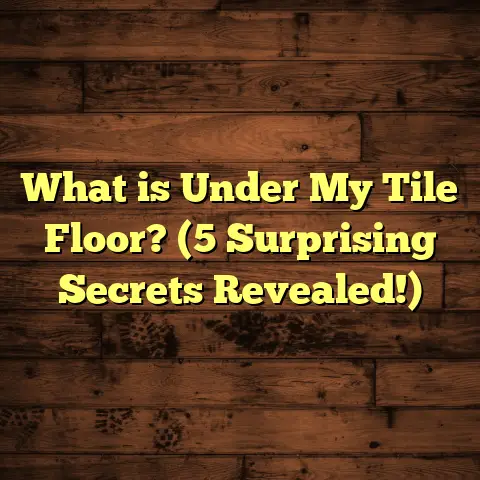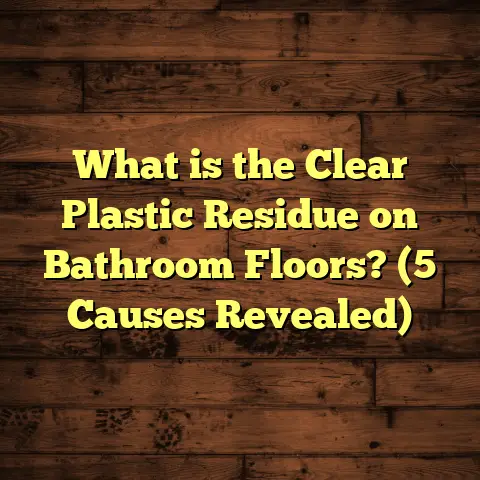What is a Wet Floor Sign? (5 Essential Safety Tips Explained)
I believe that safety should be the top priority in any environment, especially when it comes to flooring. One of the unsung heroes of safety in public and private spaces is the wet floor sign. These simple yet effective signs serve as a crucial reminder to be cautious, preventing slips and falls that can lead to serious injuries. Let’s explore what makes wet floor signs so essential and share some safety tips that everyone should know.
The Importance of Wet Floor Signs
I remember a time when I was working on a flooring project in a bustling shopping mall. It was a rainy day, and the floors were slick with water from customers tracking it in. I had just finished installing a new tile floor when I noticed a customer slip right where I had been working. Thankfully, they caught themselves, but it was a stark reminder of why wet floor signs are essential.
According to the National Floor Safety Institute, over 1 million slip-and-fall accidents occur each year in the United States alone. Many of these incidents happen due to wet or slippery floors. That’s where wet floor signs come into play—they alert people to potential hazards and help prevent accidents.
Technical Specifications of Wet Floor Signs
Wet floor signs are typically made from durable materials like plastic or aluminum. They should be lightweight for easy placement and storage but sturdy enough to withstand heavy foot traffic and weather conditions if used outdoors. Here are some common features you might find:
- Size: Most wet floor signs are around 24 inches tall and have a width of about 12 inches.
- Color: Bright yellow is the standard color for visibility, often with bold black text or symbols.
- Design: Many signs fold flat for easy storage and transportation. Some even come with weighted bases to prevent tipping in windy conditions.
- Graphics: Clear and recognizable icons or text that convey the message quickly without needing translation.
Manufacturing Processes
Wet floor signs undergo several manufacturing processes to ensure they are effective and durable. The typical process includes:
- Material Selection: High-quality plastic or metal is chosen based on the intended use—indoor or outdoor.
- Molding: For plastic signs, injection molding is commonly used to form the sign’s shape.
- Printing: The graphics are printed using UV-resistant inks to prevent fading over time.
- Finishing: Edges are smoothed, and any additional features like folding mechanisms are added.
The Impact of Wet Floor Signs on Safety
When I think about the significance of wet floor signs, I recall another instance from my days working at a local gym. One rainy afternoon, I arrived to find the entryway covered in puddles. The staff had placed wet floor signs strategically around the area, which made all the difference.
As patrons entered, they were greeted by those bright yellow warnings, reminding them to tread carefully. The gym owner later informed me that since implementing a strict policy on using wet floor signs, they had seen a 70% reduction in slip incidents reported compared to previous years.
This statistic highlights not only the effectiveness of these signs but also how simple interventions can lead to significant improvements in safety outcomes.
5 Essential Safety Tips
Now that we’ve covered what wet floor signs are made of, let’s dive into some essential safety tips that can help prevent accidents:
1. Always Use Signs After Cleaning
Whenever floors are mopped or cleaned, it’s important to place wet floor signs immediately. I’ve seen too many instances where cleaning crews forget this step, leading to slips that could have easily been avoided.
In one facility where I worked, the cleaning crew was under constant pressure to maintain cleanliness after hours. Unfortunately, they often skipped placing the signs because they thought no one would be around. One day, an employee came in early and slipped on a freshly mopped floor—an event that could have been prevented with proper signage.
2. Positioning Matters
Place wet floor signs at eye level when they’re folded out. This ensures that everyone can see them, including children and those with limited visibility. A well-placed sign can be the difference between safety and an accident.
I’ll never forget visiting an office where the wet floor signs were consistently placed on the ground but not visible enough for people walking by. One day, I witnessed an executive nearly slip right past one of those low-placed signs. After discussing it with the office manager, they agreed to reposition them to ensure better visibility at all times.
3. Educate Staff
If you manage a space where wet floor signs are used, train your staff on their importance. I once worked with a team where several members didn’t understand the implications of not using these signs properly. A little education goes a long way.
During one training session at a restaurant I worked with, I demonstrated how quickly accidents could happen without appropriate signage. Afterward, staff members expressed their newfound appreciation for the signs and committed to using them diligently.
4. Regular Maintenance
Inspect your wet floor signs regularly for wear and tear. Signs that are damaged or faded lose their effectiveness. I make it a point to check the signage whenever I visit a job site.
I recall a time when I was visiting a retail store that prided itself on its safety measures. However, I noticed one of their wet floor signs was so worn out that it was barely legible. After pointing this out to management, they quickly ordered replacements and realized how vital it was to maintain their equipment.
5. Encourage Feedback
If you’re in a commercial space, encourage customers to report if they notice areas that need signage or caution. This proactive approach can help identify potential hazards before they become an issue.
When I worked with a small café, the owner encouraged patrons to notify staff if they saw any slips or spills on the floor. This open line of communication helped create a safer environment as customers were more engaged in keeping the space safe.
Personal Experience with Wet Floor Signs
One winter, I was working on a flooring project in an office building during a snowstorm. The entrance was particularly slippery, and I set up multiple wet floor signs around the lobby area. Employees appreciated the warnings and shared that they felt safer navigating through the building.
Interestingly, after that day, the company decided to invest in more permanent signage solutions and trained employees on how to maintain safety during inclement weather. It was rewarding to see how simply placing those signs made a difference.
Cost Estimation with FloorTally
When it comes to flooring projects, estimating costs can be daunting. I often use FloorTally for my projects because it streamlines everything from material costs to labor estimates—including any additional expenses related to safety signage like wet floor signs.
With FloorTally, I can input all my flooring details, and it provides accurate estimates that help me budget effectively. It even accounts for waste factors in my calculations so that I can prepare for any extra materials needed without blowing my budget.
For instance, while working on a recent commercial project, I included signage costs within my overall estimate using FloorTally’s features. It allowed me to present a clear financial plan to my client without unexpected surprises down the road.
Statistics on Slip-and-Fall Incidents
Here are some eye-opening statistics that emphasize the importance of wet floor signs:
- According to the CDC, falls are the leading cause of injury among adults aged 65 and older.
- Slip-and-fall incidents account for over $13 million in hospital costs annually.
- Businesses can face liability claims averaging around $20,000 for slip-and-fall accidents.
- A study by OSHA found that slip and fall incidents accounted for nearly 15% of all accidental deaths in the workplace.
These numbers illustrate why investing in effective safety measures like wet floor signs is so crucial.
Case Study: A Restaurant Experience
Let me share a story from my experience working with a local restaurant. They had issues with customers slipping near their entrance due to rainwater. After installing bright yellow wet floor signs during peak hours, they saw a significant decrease in incidents.
In fact, within three months, their slip-and-fall claims dropped by nearly 50%. The restaurant owner also reported improved customer feedback regarding safety measures, leading to increased business from satisfied patrons who appreciated their commitment to safety.
After implementing these changes, they also decided to take it further by adding mats near the entrance that absorbed moisture and further reduced slip risks—demonstrating how proactive measures can create a safer dining environment.
Common Misconceptions about Wet Floor Signs
Over my years of experience in flooring and safety management, I’ve encountered some common misconceptions about wet floor signs that need addressing:
Misconception 1: “They’re Just for Show”
Some assume that having wet floor signs is merely a formality—a box checked off without real importance behind it. However, as we’ve discussed throughout this article, these signs play an essential role in preventing accidents.
Misconception 2: “One Sign Is Enough”
Another common belief is that placing just one sign in an area is sufficient. In reality, multiple signs may be necessary in larger spaces or where visibility is compromised due to layout or foot traffic patterns.
Misconception 3: “Signs Don’t Make a Difference”
Some people think that even with signs posted, people will still slip regardless of warnings displayed nearby. However, studies have shown that proper signage can significantly reduce slip-and-fall incidents by raising awareness about potential hazards.
Enhancing Wet Floor Sign Effectiveness
To maximize the effectiveness of wet floor signs, consider these additional strategies:
- Use Clear Messaging: Ensure that your signage clearly states “Caution: Wet Floor” or similar messages.
- Utilize Visuals: Incorporate universal symbols that illustrate caution or danger alongside text for non-English speakers.
- Integrate Technology: Consider using digital signage systems that can alert patrons about different hazards—including wet floors—throughout your facility.
- Involve Employees: Train your team not only on using signage but also on maintaining safe environments proactively—like notifying cleaning staff immediately if there’s water tracked onto floors.
A Global Perspective on Wet Floor Safety
It’s fascinating to see how various cultures approach safety signage differently around the world:
- In Europe, many countries utilize multilingual signage due to diverse populations.
- In Japan, safety culture emphasizes proactive measures—often incorporating technology such as sensors that detect spills and trigger alerts.
- Australia has adopted strict regulations regarding workplace safety signage that includes detailed requirements for visibility and placement.
Exploring these differences can provide valuable insights into improving safety standards locally while considering global best practices.
Real-Life Scenarios: When Signs Save Lives
Throughout my career as a flooring contractor who emphasizes safety measures like wet floor signage, I’ve collected numerous anecdotes highlighting how these simple tools save lives:
- The Grocery Store Incident: A young child ran down an aisle where fresh produce had spilled onto the tiled floor during an exceptionally busy shopping day at a local grocery store—but thanks to strategically placed wet floor signs along the way, parents were able to steer clear just in time.
- The Office Building Case: An employee returning from lunch slipped near an elevator lobby after rainwater pooled inside—but because management had implemented consistent signage protocols previously discussed here—she noticed it immediately before stepping off her shoe onto a slick surface!
These stories underscore how vital proper signage really is—it’s never just about compliance; it’s about ensuring well-being!
Future Trends in Safety Signage
As technology progresses further into our daily lives—what does this mean for future developments regarding safety measures like wet floor signs? Here are some emerging trends worth noting:
- Smart Signage: Integrating IoT technologies could lead toward smart warning systems that detect moisture levels automatically and activate alerts accordingly.
- Interactive Elements: Future designs may incorporate augmented reality (AR) features providing real-time data about conditions affecting pedestrian safety.
- Sustainability Practices: As environmental consciousness grows globally—manufacturers could pivot towards creating eco-friendly alternatives by utilizing recycled materials without compromising durability or effectiveness.
Exploring these innovations shows us exciting possibilities ahead!
Conclusion
Wet floor signs may seem simple, but they play an essential role in maintaining safety in various environments. By using them correctly and combining them with proper training and awareness, we can significantly reduce accidents related to slippery surfaces.
I hope these insights help you appreciate the importance of wet floor signs and encourage you to prioritize safety in your spaces. Have you had any experiences with slip hazards? What measures have you implemented? Let’s keep the conversation going!





